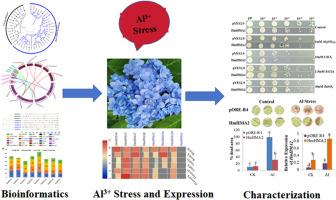Genome wide analysis of HMA gene family in Hydrangea macrophylla and characterization of HmHMA2 in response to aluminum stress
IF 6.1
2区 生物学
Q1 PLANT SCIENCES
引用次数: 0
Abstract
Aluminum toxicity poses a significant threat to plant growth, especially in acidic soils. Heavy metal ATPases (HMAs) are crucial for transporting heavy metal ions across plant cell membranes, yet their role in Al3+ transport remains unexplored. This study identified eight HmHMA genes in the genome of Hydrangea macrophylla, categorizing them into two major clades based on phylogenetic relationships. These genes were found unevenly distributed across six chromosomes. Detailed analysis of their physicochemical properties, collinearity, and gene structure was conducted. RNA-seq and qRT-PCR analyses revealed that specific HmHMA genes, notably HmHMA2, were predominantly expressed in roots and flowers under Al3+ stress, indicating their potential role in Al3+ tolerance. HmHMA2 showed significant expression in roots, especially under Al3+ stress conditions, and when expressed in yeast cells, it conferred resistance to aluminum and zinc but increased sensitivity to cadmium. Overexpression of HmHMA2 in hydrangea leaf discs significantly improved Al3+ tolerance, reduced oxidative stress markers like hydrogen peroxide and malondialdehyde, and enhanced antioxidant enzyme activity such as SOD, POD and CAT compared to controls. These findings shed lights on the potential role of HmHMAs in Al transport and tolerance in H. macrophylla.

大绣球花 HMA 基因家族的全基因组分析及 HmHMA2 对铝胁迫的响应特征
铝毒性对植物生长构成严重威胁,尤其是在酸性土壤中。重金属 ATP 酶(HMAs)是重金属离子跨植物细胞膜转运的关键,但它们在 Al3+ 转运中的作用仍未得到探索。本研究在大绣球花的基因组中发现了 8 个 HmHMA 基因,并根据系统发育关系将其分为两大支系。这些基因不均匀地分布在六条染色体上。研究人员对这些基因的理化性质、共线性和基因结构进行了详细分析。RNA-seq 和 qRT-PCR 分析表明,特定的 HmHMA 基因,特别是 HmHMA2,在 Al3+ 胁迫下主要在根和花中表达,这表明它们在耐受 Al3+ 的过程中可能发挥作用。HmHMA2在根中有显著表达,尤其是在Al3+胁迫条件下,当它在酵母细胞中表达时,可赋予酵母细胞对铝和锌的抗性,但增加了对镉的敏感性。与对照组相比,HmHMA2 在绣球花叶片中的过表达显著提高了对 Al3+ 的耐受性,降低了过氧化氢和丙二醛等氧化应激标记物,并增强了 SOD、POD 和 CAT 等抗氧化酶的活性。这些发现揭示了 HmHMAs 在大叶黄杨的铝迁移和耐受性中的潜在作用。
本文章由计算机程序翻译,如有差异,请以英文原文为准。
求助全文
约1分钟内获得全文
求助全文
来源期刊
CiteScore
11.10
自引率
3.10%
发文量
410
审稿时长
33 days
期刊介绍:
Plant Physiology and Biochemistry publishes original theoretical, experimental and technical contributions in the various fields of plant physiology (biochemistry, physiology, structure, genetics, plant-microbe interactions, etc.) at diverse levels of integration (molecular, subcellular, cellular, organ, whole plant, environmental). Opinions expressed in the journal are the sole responsibility of the authors and publication does not imply the editors'' agreement.
Manuscripts describing molecular-genetic and/or gene expression data that are not integrated with biochemical analysis and/or actual measurements of plant physiological processes are not suitable for PPB. Also "Omics" studies (transcriptomics, proteomics, metabolomics, etc.) reporting descriptive analysis without an element of functional validation assays, will not be considered. Similarly, applied agronomic or phytochemical studies that generate no new, fundamental insights in plant physiological and/or biochemical processes are not suitable for publication in PPB.
Plant Physiology and Biochemistry publishes several types of articles: Reviews, Papers and Short Papers. Articles for Reviews are either invited by the editor or proposed by the authors for the editor''s prior agreement. Reviews should not exceed 40 typewritten pages and Short Papers no more than approximately 8 typewritten pages. The fundamental character of Plant Physiology and Biochemistry remains that of a journal for original results.

 求助内容:
求助内容: 应助结果提醒方式:
应助结果提醒方式:


